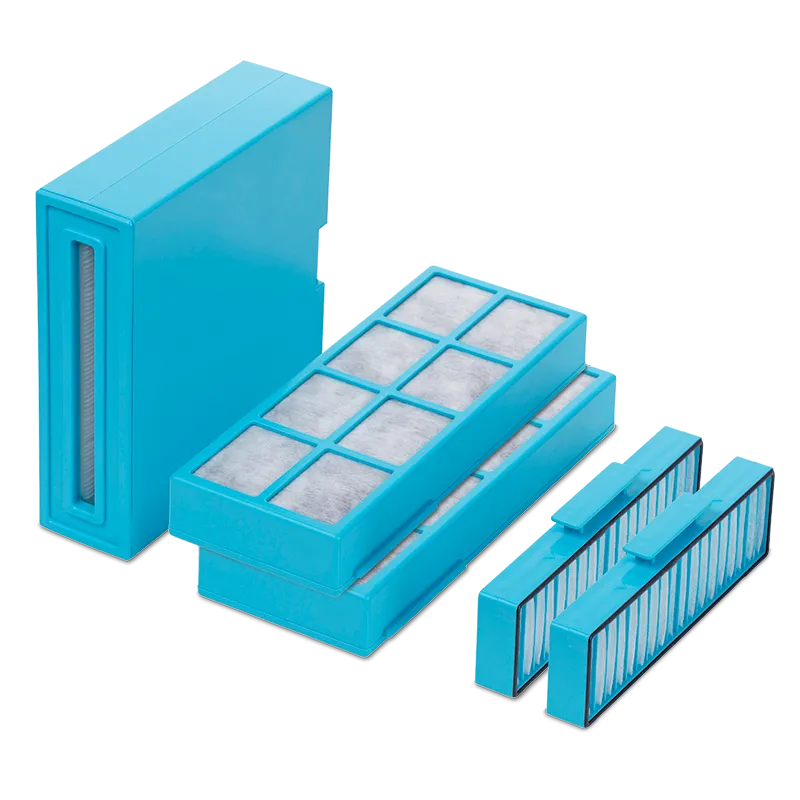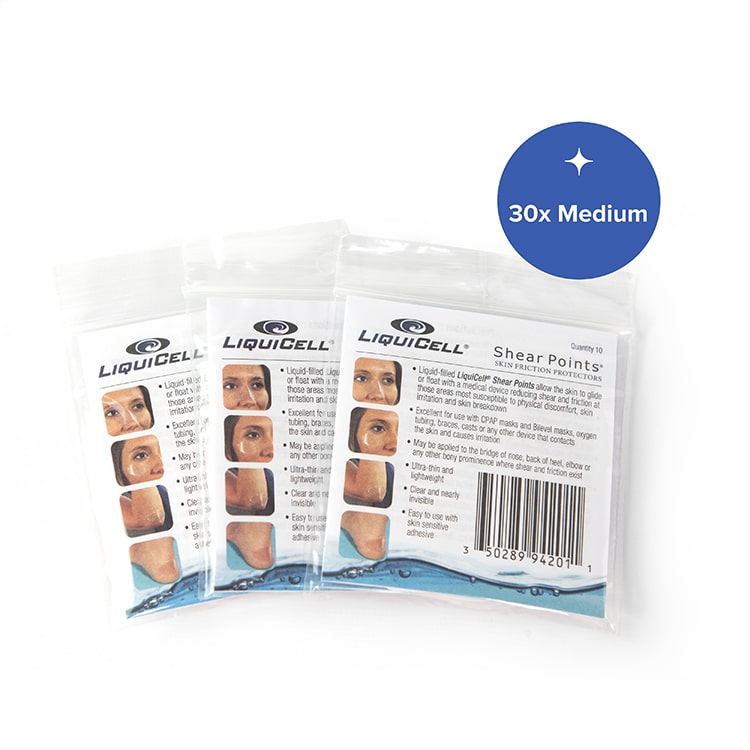Air Purifier for Odors
The human nose is very sensitive to small concentrations of certain compounds. We experience the sensation of an odor when an airborne molecule bonds to the surface of special receptors in our nose.1 Since it can require a very small amount of a substance in the air to produce a smell,2 even limited sources of air contamination can be detected. Volatile organic compounds, carbon-containing molecules which evaporate at room temperature, comprise a wide range of smells. An activated carbon filter, such as the kind found in an air purifier for odors, can reduce or remove these smells.
SoClean 3-Stage Air Purifier+
Superpowered Nose
Some chemicals can be detected by the human nose in incredibly miniscule amounts. For example, a citrusy-smelling volatile organic compound called (Z)8-tetradecenal can be detected at concentrations of less than one in 100 billion.3 In other words, if one molecule for every 100 billion molecules in the air you inhale is an (Z)8-tetradecenal, you will be able to smell it.
With such an outsized ability, it is no wonder that it can be difficult to remove smells or odors from a living or working space. Even if you successfully eliminate the source of the smell, the molecules can continue to float around for long after the source is gone.
Activated Charcoal
An air purifier with a carbon filter will circulate air through a filter of activated carbon, also called activated charcoal. The activated carbon has an enormous surface area relative to the volume it occupies, sometimes nearly as high as 4,000 square meters per gram.4 All of that surface area provides plenty of places for volatile organic compounds to adsorb, or adhere to the surface, of the carbon. The process is so effective that it is used to eliminate the smell of sewage from the gases that are released during waste treatment.5
SoClean 3-Stage Air Purifier+
Shop NowBeyond Smell
In addition to being able to greatly reduce the incidence of smells and odors, a properly designed and maintained air purifier can improve air quality. In fact, some of the compounds we can smell are actually harmful chemicals. Benzene, a carcinogen, is detectable in concentrations as low as 1.5 parts per million.6 Removing this harmful substance from the air can benefit your health.
An air purifier for odors that uses an activated carbon filter can also serve as an effective air purifier for chemicals. Sometimes called an electric air cleaner, before the air is passed through the activated carbon, some type of filter for particulate matter is often used to prevent the carbon filter from becoming clogged. A HEPA air purifier is incredibly efficient at removing particulate matter like soot, dust, mold spores, and bacteria.
More Products from SoClean
SoClean Air Purifier+ Filter Kit
$149
Portable Outlet CPAP Backup Battery V2
Save $50!
New and improved model - when the power goes out, your CPAP stays on!
Just plug the new Portable Outlet UPS between your CPAP equipment and your bedside wall socket to protect from loss of power due to storms or outages.
$349
LiquiCell Shear Points, 30 Skin Friction Protectors, Medium
Great for use anywhere skin would benefit from cushioning and protection. Ultra-thin, liquid-filled strips protect skin and stay in place.
FSA/HSA eligible LiquiCell Shear Points are latex-free, ultrathin, clear liquid-filled membranes that provide a synthetic, external cushion. It reduces painful friction by allowing an object to glide or float over the skin. Gentle skin adhesive keeps LiquiCell Shear Points securely in place overnight, while allowing easy and painless removal in the morning.
Medium, 30 per box, each 2.75" wide by 1.3" high
Also available: Small (30 per box, each 2.2" wide by 1.1" high) LiquiCell Shear Points are excellent for use on the bridge of the nose to reduce irritation from sleep equipment such as face masks.
$19.95
FAQs
It depends on what method the air purifier uses to purify the air. A simple HEPA or ULPA filter that uses inert, fibrous media to capture particles from the air may not have an impact on odor. Air purifiers that use photocatalytic destruction to purify the air can greatly reduce the incidence of volatile organic compounds that constitute odors. Activated carbon filtration is very effective for odor control.8
The best way to eliminate an odor is to eliminate the source of the odor. The human nose is very sensitive and is able to detect very small traces of molecules, so removing the source of the smell will go a long way towards removing the smell. If the odor persists after removing the source of the odor, a professional service can treat your living space to remove persistent smells. For ongoing odor reduction, an activated carbon filter is effective.
Activated charcoal or activated carbon filters are very effective at removing odors. Keep in mind that an activated charcoal filter has a given lifetime. The amount of time a carbon or charcoal filter will remain useful depends on how heavily it is used. Once the filter has become saturated with odors and other volatile organic compounds, it can no longer remove odors from the air and will need to be replaced.
Boiling vinegar may temporarily overpower other smells. Unless you remove the source of the odor, once you stop boiling the vinegar, the odor will return. An air purifier for odors will continuously remove smells until the carbon filter becomes saturated, at which point the filter will need to be changed.
Why SoClean
Get cleanroom quality clean air at home with the SoClean 3-Stage Air Purifier+. The SoClean 3-Stage Air Purifier+ captures 99.99999% of airborne viruses and bacteria. The SoClean 3-Stage Air Purifier greatly outperforms HEPA standards in a portable package that can be easily moved from place to place.
Master Air Purifier Sources:
Air quality sources: Air purification/filtration process sources: HEPA, UPLA, and MERV filter sources:
https://www.smu.edu.sg/sites/default/files/economics/shea2014/presentation/pollution_talk_april_2014_ham2.pdf
https://www.airnow.gov/aqi/aqi-basics/
https://www.ncbi.nlm.nih.gov/pmc/articles/PMC4484965/
https://www.sciencedirect.com/science/article/abs/pii/S0048969701007653
https://www.cfp.ca/content/57/8/881/tab-figures-datad1
https://ehp.niehs.nih.gov/doi/full/10.1289/ehp.1002255
https://www.gotopac.com/art-cr-iso-cleanroom-classifications
https://www.researchgate.net/publication/316472615_A_review_of_air_filtration_technologies_for_sustainable_and_healthy_building_ventilation
https://www.epa.gov/indoor-air-quality-iaq
https://www.airnow.gov/sites/default/files/2020-05/aqi-technical-assistance-document-sept2018.pdf
https://www.health.ny.gov/environmental/indoors/air/pmq_a.htm#:~:text=Exposure%20to%20fine%20particles%20can,as%20asthma%20and%20heart%20disease
https://www.epa.gov/sites/production/files/2018-07/documents/residential_air_cleaners_-_a_technical_summary_3rd_edition.pdf
https://www.ncbi.nlm.nih.gov/pmc/articles/PMC6272289/
https://link.springer.com/article/10.1007%2Fs100220100046
https://www.kompareit.com/homeandgarden/hvac-compare-central-air-cleaner-cost.html
https://www.chemviron.eu/products/activated-carbon/
https://www.who.int/occupational_health/publications/en/oehairbornedust3.pdf
https://academic.oup.com/jimb/article/32/7/319/5992784?login=true
https://www.cabotcorp.com/solutions/products-plus/activated-carbon
https://www.sciencedirect.com/science/article/abs/pii/S009167499970391X
https://www.tandfonline.com/doi/full/10.3109/02770903.2014.895011
https://www.ashrae.org/file%20library/about/position%20documents/filtration-and-air-cleaning-pd.pdf
https://www.britannica.com/science/human-respiratory-system/The-mechanics-of-breathing
https://www.epa.gov/pm-pollution/particulate-matter-pm-basics
https://www.merriam-webster.com/dictionary/HEPA
https://www.standards.doe.gov/standards-documents/3000/3020-astd-2015
https://www.standards.doe.gov/standards-documents/3000/3020-astd-2015/@@images/file
https://www.sciencedirect.com/science/article/abs/pii/S0195670105005074
https://www.ncbi.nlm.nih.gov/pmc/articles/PMC1477932/
https://pediatrics.aappublications.org/content/127/1/93.short
https://www.tandfonline.com/doi/full/10.1080/02786820500191348
https://www.sciencedirect.com/science/article/abs/pii/0360128583900023
https://onlinelibrary.wiley.com/doi/abs/10.1002/ajim.4700270302
https://www.laboratory-supply.net/blog/difference-between-a-hepa-and-ulpa-filter/
https://www.sciencedirect.com/science/article/abs/pii/S0360132320305588
https://www.karger.com/Article/Abstract/151502
https://www.grainger.com/know-how/equipment-information/kh-what-is-merv-rating-air-filter-rating-chart
https://www3.epa.gov/ttn/catc/dir1/ff-hepa.pdf
https://www.epa.gov/indoor-air-quality-iaq/what-merv-rating-1
ttp://gttlab.com/uploads/soft/161025/EN1822-5-2009Highefficiencyairfilters(EPA,HEPAandULPA)Part5Determiningtheefficiencyoffilterelements.pdf
Sources:
- https://www.ncbi.nlm.nih.gov/pmc/articles/PMC4491593/
- https://patents.google.com/patent/US7332468B2/en
- https://patents.google.com/patent/US7332468B2/en
- https://link.springer.com/article/10.1007/s10934-015-0035-5
- https://www.jstor.org/stable/25039942?seq=1
- https://www.cdc.gov/niosh/ershdb/emergencyresponsecard_29750032.html#:~:text=Benzene%20has%20a%20sweet%2C%20aromatic,inadequate%20for%20more%20chronic%20exposures.
- https://www.sciencedirect.com/science/article/abs/pii/S092633739700012X
- https://www.jstor.org/stable/25039942?seq=1










